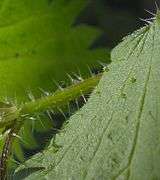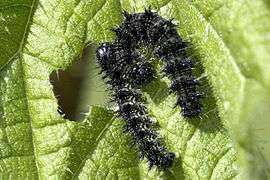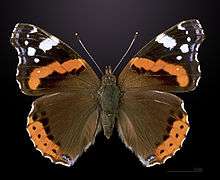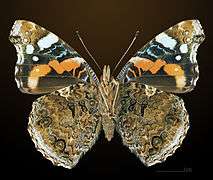Vanessa atalanta
| Red Admiral | |
|---|---|
 | |
| dorsal view | |
_underside_3.jpg) | |
| ventral view | |
| Scientific classification | |
| Kingdom: | Animalia |
| Phylum: | Arthropoda |
| Class: | Insecta |
| Order: | Lepidoptera |
| Family: | Nymphalidae |
| Genus: | Vanessa |
| Species: | V. atalanta |
| Binomial name | |
| Vanessa atalanta (Linnaeus, 1758) | |
| Subspecies | |
| |
| Synonyms | |
| |
The Red Admiral (Vanessa atalanta) is a well-known colourful butterfly, found in temperate Europe, Asia and North America. The Red Admiral has a 45–50 mm (1.8–2.0 in) wing span.[2] The species is resident only in warmer areas, but migrates north in spring, and sometimes again in autumn.
This medium-sized butterfly is identified by its striking dark brown, red, and black wing pattern. More specifically, the dark wings possess orange bands that cross the fore wings and on the outer edge of the hind wings; white spots on the dorsal fore wings near the front margin; reddish bars on dorsal surface of all four wings. The caterpillar feeds on nettles, and the adult drinks from flowering plants like the Buddleia and overripe fruit.
In northern Europe, it is one of the last butterflies to be seen before winter sets in, often feeding on the flowers of ivy on sunny days. The Red Admiral is also known to hibernate,[3] re-emerging individuals showing prominently darker colourings than first brood subjects. The butterfly also flies on sunny winter days, especially in southern Europe.
In North America, the Red Admiral generally has two broods from March through October. Most of North America must be recolonized each spring by southern migrants, but this species over-winters in south Texas.
The Red Admiral is the butterfly featured by Vladimir Nabokov, an amateur lepidopterist, in his novel Pale Fire.
Life cycle
-

Eggs
-

Early instar
-
.jpg)
Late instar
-

Chrysalis
-

Dorsal side
-

△ ventral side
Host plants
Plants of the nettle family (Urticaceae) including stinging nettle (Urtica dioica), tall wild nettle (U. d. gracilis), wood nettle (Laportea canadensis), false nettle (Boehmeria cylindrica), pellitory (Parietaria pennsylvanica), mamaki (Pipturus albidus), and possibly hops (Humulus).
Etymology
Atalanta is a figure in Greek mythology, a strong yet feminine woman who faces obstacles and backlash for refusing to follow gender norms.
References
- Tucker, Mike and Ceney, Bryan (1997) The Red Admiral Butterfly. Butterfly Conservation, Colchester, UK, 32p. ISBN 0-9522602-5-5
- "Vanessa atalanta". Integrated Taxonomic Information System. Retrieved 6 February 2006.
- Red Admiral on Bugguide.net
Footnotes
Further reading
- Glassberg, Jeffrey Butterflies through Binoculars, The West (2001)
- Guppy, Crispin S. and Shepard, Jon H. Butterflies of British Columbia (2001)
- James, David G. and Nunnallee, David Life Histories of Cascadia Butterflies (2011)
- Pelham, Jonathan Catalogue of the Butterflies of the United States and Canada (2008)
- Pyle, Robert Michael The Butterflies of Cascadia (2002)
External links
| External identifiers for Vanessa atalanta | |
|---|---|
| Encyclopedia of Life | 154665 |
| Also found in: Wikispecies | |
- Red admiral on the University of Florida / Institute of Food and Agricultural Sciences Featured Creatures website
- Red Admiral Butterfly: Large format reference quality (free) photographs Cirrus Digital Imaging
- HD video of Vanessa butterflies
- Red Admiral, Canadian Biodiversity Information Facility
- Red Admirals in California
- Butterflies and Moths of North America - Vanessa atalanta
- Butterflies of America - Vanessa atalanta
| Wikimedia Commons has media related to Vanessa atalanta. |